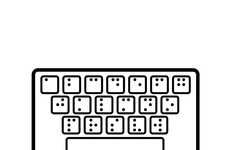
The Braille App Brings Touchscreen Technology to the Visually Impaired
Susan Keefe — October 12, 2011 — Lifestyle
Braille dependent persons have long been excluded from participating in the powerful revolution of touchscreen technology, but thanks to the Braille App the visually impaired can now engage with tablets with a new-found level of ease. The app was developed by NMSU undergraduate Adam Duran, Stanford Assistant Professor Adrian Lew and Stanford Doctoral candidate Sohan Dharmaraja, attempts to bring Braille to the iPad. It was created as part of the Army High-Performance Computing Research Center's (AHPCRC) two-month summer immersion course.
Most Braille laptops are expensive and not at all practical in most day-to-day scenarios. Using the eight-button keyboard the team managed to create keys capable of orienting themselves to the correct finger when the user touches the screen. The digital buttons are fully customizable, adjusting to accommodate the size of the user's fingers, and how they hold their hands while typing.
The Braille App for the iPad is an inclusive technological breakthrough; and according to Professor Charbel Farhat, the Braille App of the iPad does what "no standard Braille writer can do."
Most Braille laptops are expensive and not at all practical in most day-to-day scenarios. Using the eight-button keyboard the team managed to create keys capable of orienting themselves to the correct finger when the user touches the screen. The digital buttons are fully customizable, adjusting to accommodate the size of the user's fingers, and how they hold their hands while typing.
The Braille App for the iPad is an inclusive technological breakthrough; and according to Professor Charbel Farhat, the Braille App of the iPad does what "no standard Braille writer can do."
Trend Themes
1. Touchscreen Accessibility - Developing more mobile and low-cost technologies that bring touchscreen capabilities to those with visual impairments.
2. Customizable Interfaces - Creating adaptable interfaces to accommodate for differing levels of vision, finger size and typing style to improve accessibility to new technology.
3. Assistive Technology for Disabilities - Continuing the development of innovative tech to support all kinds of disabilities for more inclusive computing.
Industry Implications
1. Healthcare Technology - Bringing this same level of innovation to medical devices and interfaces to improve patient accessibility and overall quality of care.
2. Education Technology - Providing accessible technology platforms and tools to educators that are specifically designed for students who have visual impairments or other disabilities.
3. Consumer Electronics - Improving the accessibility of touch-based devices such as smartphones, laptops, and tablets and exploring new tactile interfaces to increase usability for people with disabilities.
1.9
Score
Popularity
Activity
Freshness















